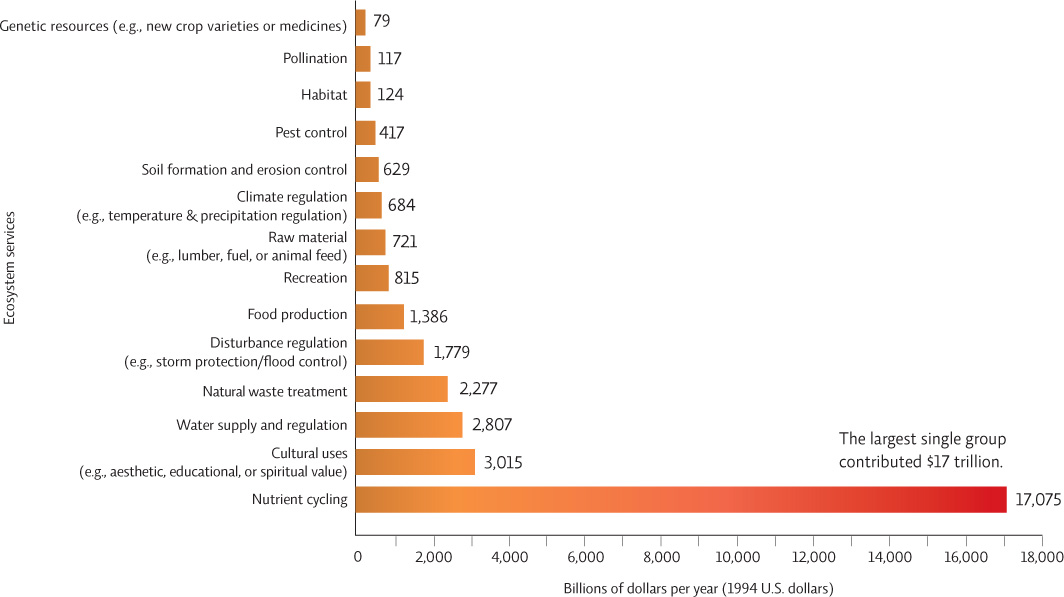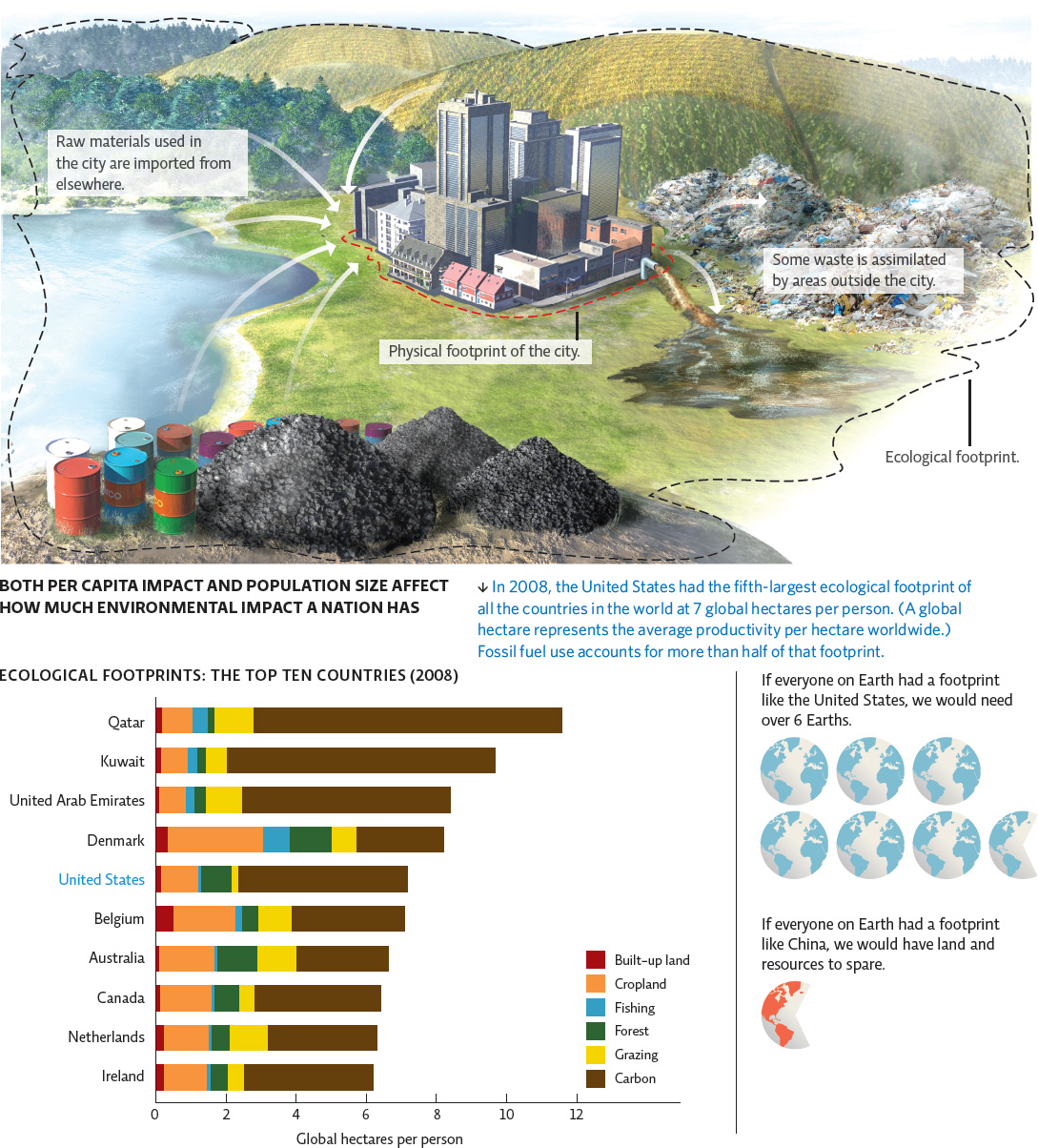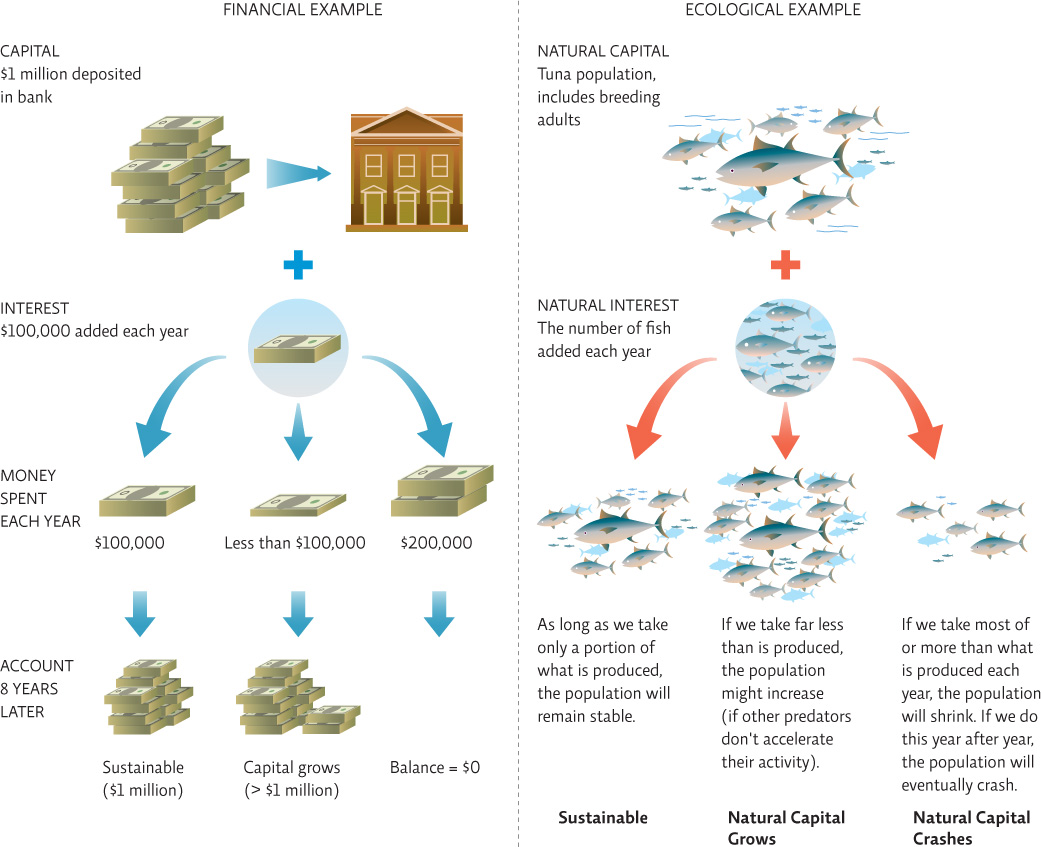Businesses and individuals impact the environment with their economic decisions
The choices businesses (and, by extension, consumers) make have tremendous impacts on the environment. The amount and type of energy and water they use, the way they handle the waste they produce, the raw materials they use—these decisions affect not only business operations themselves but also Earth as a whole, especially considering the magnitude of the resources and waste that some large businesses use and produce.
KEY CONCEPT 6.1
All species on Earth, including humans, depend on ecosystem services provided by nature. Recognizing the value of these services may motivate us to protect them.
Businesses that are environmentally mindful aren’t limited to simply trying to minimize their impact on nature; they can actually look to nature as an economic model from which to learn and model their choices. After all, economics—the social science that deals with how we allocate scarce resources—is not just about money. Most of the resources we depend on actually come from the environment. Environmental resources like timber and water can be considered ecosystem goods. And ecological processes like water purification, pollination, climate regulation, and nutrient cycling are essential and economically valuable ecosystem services, according to work published by Robert Costanza, an ecological economist currently at Australian National University. We take many of these services and resources for granted, but some are priceless because there are no substitutes—such as the oxygen produced by green plants, which we need in order to survive. INFOGRAPHIC 6.1
economics
The social science that deals with the production, distribution, and consumption of goods and services.
ecosystem services
Essential ecological processes that make life on Earth possible.
VALUE OF ECOSYSTEM SERVICES
Robert Costanza and his colleagues evaluated Earth’s ecosystem services and quantified their values to be more than $33 trillion (1994 dollars). The estimate in 2009 dollars is $44 trillion. Though the figures are considered to be gross underestimates, especially for entities hard to quantify like habitat and genetic resources, they point out that ecosystems provide us with valuable, sometimes irreplaceable, services but that they can continue to do this only to the degree that human impact will allow. When we degrade ecosystems, we reduce their ability to provide these services.


How would the price of food be affected if we incorporated the ecosystem services of pollination, pest control, soil formation, and water supply into that price?
The price would likely go up as steps would have to be taken to protect or provide these services in the food production process.
When ecosystems are intact, they are naturally sustainable: They rely on renewable resources and also provide services that help relplenish and recycle these resources. But ecosystems will only be able to provide us with their valuable goods and services as long as we let them. As Anderson came to realize, when we degrade ecosystems by using more from them than can be replenished, we threaten our planet’s ability to provide the services we need, and this ultimately threatens our own future. By using nature as a model, businesses can lessen their impact on the environment and still make choices that support a viable industrial economy.
102
KEY CONCEPT 6.2
Human impact can be measured in terms of our ecological footprint—the amount of land needed to support our lifestyle.
Like many other businesses, Interface Carpet has a large ecological footprint—that is, the land needed to provide its resources and assimilate its waste (typically expressed as hectares [ha] or acres [ac] per person or population). The ecological footprint is a value that businesses, individuals, and populations use to quantify their impact on the environment. INFOGRAPHIC 6.2
ECOLOGICAL FOOTPRINT
The ecological footprint is the land area needed to provide the resources for and assimilate the waste of a person or population and may extend far beyond the actual land occupied by the person or population; it is usually expressed as a per capita value (hectares or acres/person). The current world footprint would require about 1.5 Earths to maintain, but obviously we just have one to work with.


Identify some personal choices you could make to reduce your own ecological footprint.
ecological footprint
The land area needed to provide the resources for, and assimilate the waste of, a person or population.
Answers could include things that reduce our use of fossil fuels (drive less, walk, bike, turn down the thermostat in winter), things that reduce our use of water (shorter showers, use native plants in landscaping to reduce water needs), things that reduce our use of other resources (avoid disposable items, re-use items), etc.
The United States, for instance, has a particularly high per capita (per person) footprint, in that it requires much more land area to support each person than it actually possesses. The country is forced to import resources from other countries and even to export some waste. In fact, if the 7 billion people who populate the planet all lived like the average person in the United States, we would need the landmass of six or more Earths to sustain everyone. According to the World Wildlife Federation’s 2012 Living Planet Report, humans use 50% more resources than is ultimately sustainable. This means that unless we stop using them so quickly, we are going to run out.
What kinds of essential resources does Earth provide us? Considered in financial terms, our natural capital includes the natural resources we consume, like oxygen, trees, and fish, as well as the natural systems—forests, wetlands, and oceans—that produce some of these resources. Our natural interest is what is produced from this capital, over time—more trees and oxygen, for example—much like the interest you earn with a bank account. Natural interest represents the amount of readily produced resources that we could use and still leave enough behind to, in time, replace what we took. Natural interest might be represented by an increase in a fish population, for instance, or new growth in a forest—basically, the extra that is added in a given time frame. INFOGRAPHIC 6.3
natural capital
The wealth of resources on Earth.
natural interest
Readily produced resources that we could use and still leave enough natural capital behind to replace what we took.
CAPITAL AND INTEREST
Natural resources can be compared to the financial concepts of capital and interest. Natural capital is the wealth of resources on Earth and includes all the natural resources we use as well as the natural systems that produce some of those resources (forests, wetlands, oceans, etc.). Natural interest is the amount produced regularly that we could use and still leave enough natural capital behind to replace what we took.


Why might it be difficult to harvest a natural resource like a tuna population sustainably, even if we set that as our goal?
The tragedy of the commons might play a role if some fishers continue to fish unsustainably because they fear others will. It may also be hard to determine just exactly how many fish could be taken sustainably – this requires detailed understanding of the tuna population at any given site. We may overestimate what we can sustainably harvest if we overestimate the population size or reproductive potential of the population.
KEY CONCEPT 6.3
If we only harvest resources at or below the rate at which they are produced—that is, take only the natural interest—we will leave behind enough natural capital to replace what we took
If we only withdraw resources equivalent to (or less than) the natural interest, we will leave behind enough natural capital to replace what we took. When Anderson spoke to his employees in the summer of 1994 about his new plan for sustainability, he stressed that his goal was to begin putting back more than the company took from the planet; in other words, he wanted Interface to be what he called a “restorative enterprise.” Up to that point, the company was using up far more natural capital in the form of resources like petroleum and water than was ultimately sustainable. Anderson realized that if we take more than is replaced, capital will shrink and therefore produce less the next year. Essentially, by taking 50% more resources than is sustainable, we are taking resources away from the future, in what eco-architect Bill McDonough calls intergenerational tyranny. When we liquidate our natural capital more quickly than it can be replaced and call that “income,” the question becomes this: Where will future income come from?
This can be an especially big problem with commonly held resources like water: Once we remove it from wells or rivers, we have to wait for the next rainfall to replenish it. When many users are accessing the resource, it can quickly become degraded if they do not work together to manage it—a tragedy of the commons (see Chapter 1).
From 1994 to 2006, Interface made major changes in order to achieve its new goals. The company cut the amount of energy it derived from fossil fuels by 55% and reduced its total energy use by 43%. It did this in part by maximizing energy efficiency in its facilities, installing skylights and solar tubes to replace artificial, electricity-dependent lighting, and installing more energy-efficient heating, ventilation, and air conditioning systems. In one of its factories, Interface also installed a real-time energy tracker that displays energy use prominently for its employees to see, inspiring them to think of new ways to conserve energy. Although Interface declined to reveal how much money it invested in such improvements and technology, the company has ultimately recouped its costs in energy savings, according to a company spokesperson.
Researchers often use the IPAT model to estimate the size of a population’s ecological footprint, or impact (I), based on three factors: population (P), affluence (A), and technology (T). The premise is that as population size increases, so does impact. More affluent and technology-dependent populations use more resources and generate more waste than do less affluent and technology-dependent populations; technology allows us to build more things, dig deeper, and fly higher, all of which drain the environment. INFOGRAPHIC 6.4
IPAT model
An equation (I = P × A × T) that measures human impact (I), based on three factors: population (P), affluence (A), and technology (T).
THE IPAT EQUATION
Population (P), affluence (A), and technology (T) all affect how much of an impact an individual or a population has on the environment. As any or each of these factors increase, so does the population’s overall impact, as indicated by the model’s equation: I = P × A × T. The right kind of technology can actually lower overall impact, in which case the equation becomes I= (P × A)/T.


Identify some technologies that you use that increase your impact. Are there alternative technologies you could use (or propose be developed) that would decrease that impact?
Technologies that capture or use sustainable energy sources would decrease impact; more fuel-efficient technologies would also reduce impact. Technologies to convert waste to new products or fuel could also decrease our impact.
103
104
KEY CONCEPT 6.4
Human impact on the environment generally increases as a population’s size, affluence, and use of technology increase. However, the right technology can reduce resource use and pollution generation, thus helping to decrease impact.
One caveat with regard to this model is that technology can have the opposite effect: Some technologies can decrease, rather than increase, environmental impact. In 2006, for instance, after deciding to become sustainable, Interface invented a new technology called TacTiles—2.5 × 2.5-inch squares of adhesive tape that join carpet tiles together. The adhesive is made from the same plastic used to make soda bottles. In contrast with traditional “spread on the floor” adhesives, Interface’s new tape does not contain any volatile organic compounds, which the U.S. Environmental Protection Agency recognizes as a health risk. TacTiles also make it possible for customers to replace single carpet tiles easily, when, for instance, there has been a spill. Although resources are still required to make TacTiles, they present fewer health risks and produce less waste than other approaches. When technologies such as TacTiles reduce the environmental footprint rather than increase it, the equation used to describe their impact changes to I = (P × A)/T.
105
In 2007, to further reduce its impact, Interface launched a major carpet-recycling initiative called ReEntry 2.0. More than 2 million metric tons (2.5 million U.S. tons) of carpet are pulled up and discarded globally each year, and less than 5% of that has historically been reused or recycled. With ReEntry 2.0, Interface developed a way to recycle carpets—both its own and those made by its competitors—to make new carpet, using only a small amount of virgin materials to do so. With ReEntry 2.0, Interface has diverted about 90,000 metric tons (100,000 U.S. tons) of material from landfills. Interface has promised to eliminate any negative impact it has on the environment by 2020, in a plan it calls “Mission Zero.”